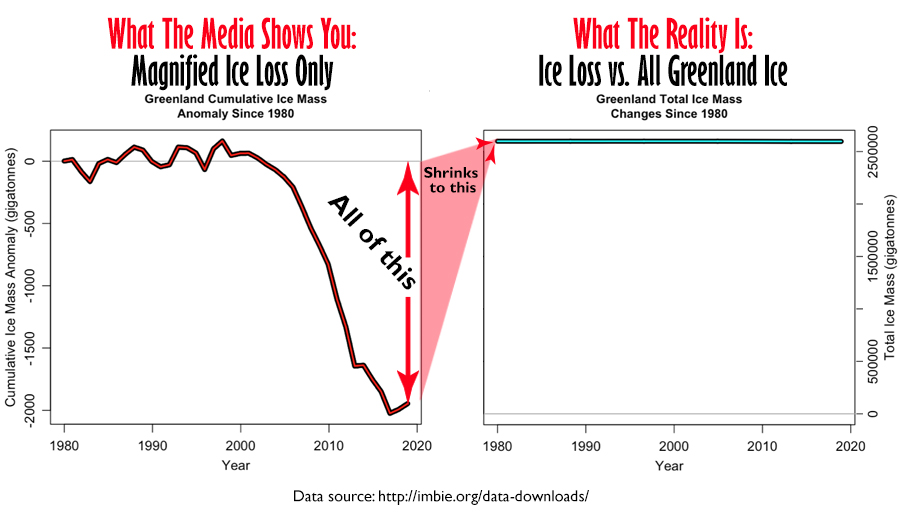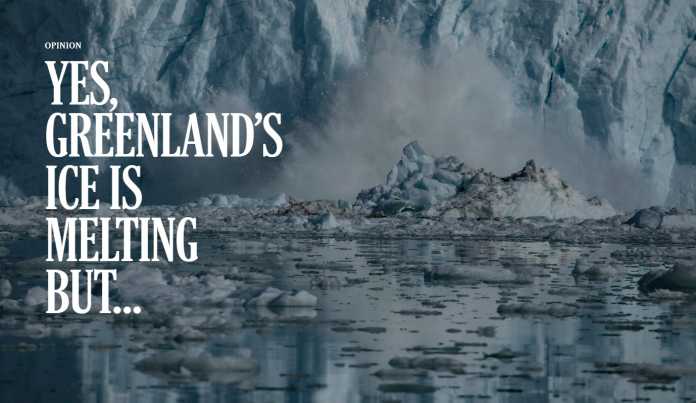The New York Times (NYT) recently published a very long op-ed by Bret Stephens, who was assigned to cover climate stories for NYT in 2017. The article, titled Yes, Greenland’s Ice is Melting But…covers the topic of melting ice and glaciers there from a hands-on perspective during a visit. While his visit is to be commended, as many journalists that cover climate issues never get away from their desk, Stephens has come away with a false conclusion about Greenland’s ice.
Stephens, who self-described in the article as having been a “climate agnostic,” seems to have been converted to a climate alarmist by what he witnessed in Greenland. The problem is that Stephens is making observations on a human time scale of a few days, whereas Greenland and its ice operate on a climatic time scale – which is at least three decades long. The full story of what is going on in Greenland can’t be derived from a single visit at a single point in time.
But, he does at least say this:
“A trip there changed my mind about climate change while reinforcing my belief that markets, not government, provide the cure.”
He’s right that government can’t solve anything when it comes to climate. Witness that the United Nations (UN) is now having their 27th meeting on climate with COP27 from Sunday, November 6, through Friday, November 18. Twenty seven climate meetings since the very first one held in Berlin, Germany in March, 1995. But, despite all those meetings pledging to do something about climate, we still have headlines like this from the UN fearmongers: “Major UN report warns that the world is close to “irreversible” climate catastrophe.” Even if the headline were true, it is clear the U.N. and world governments have accomplished nothing on climate in decades – except have more meetings.
In the case of Greenland and Bret Stephens, he cites the following experience as evidence of climate change affecting Greenland and causing ice to melt:
I asked the pilot to give me a sense of how much the glacier had retreated since he had been flying the route. He pointed to a distant rocky island in the middle of the fjord.
“That’s where the glacier was in 2007,” he said.
Over the course of the 20th century, the Jakobshavn Glacier retreated about 10 to 15 kilometers. Over just the next eight years, it retreated about the same amount, according to the oceanographer Josh Willis of NASA’s Jet Propulsion Laboratory. Later the front advanced a little — a function of complex dynamics partly involving ocean currents — before resuming its retreat.
For anyone who has entertained doubts about the warming of the planet, a trip to Greenland serves as a bracing corrective.
One glacier’s ice loss in Greenland does not make a climate trend due to warming. Where Stephens goes wrong is that glaciers like the Jakobshavn Glacier normally calve icebergs into the sea – they don’t melt all that ice into the sea. Stephens also missed this report from NASA that determined Jakobshavn Glacier Grows for Third Straight Year.
The NASA satellite data showed that Jakobshavn Glacier grew from 2016 into 2019, marking three consecutive years of growth. Somehow, Stephens didn’t mention that.
Iceberg calving is a natural complex process, with no one cause, according to this article by the Center for Polar Observation and Modeling of Leeds university, UK:
Despite its importance, a comprehensive understanding of iceberg calving remains elusive, for a number of reasons: its processes occur over a huge range of time and length scales on glaciers around the world; there are limited observations of calving – satellites passing overhead once a day or so will miss most of the action, many important processes are hidden from view beneath the water or at the bed, and the termini of calving glaciers are hazardous environments; and calving is part of a complex feedback cycle along with glacier thinning and ice flow acceleration.
Rates of calving often change annually, with calving slowing or shutting down entirely over the winter. Many different environmental factors such as melting of the glacier surface, undercutting of the calving face by warm fjord water or the resistance from sea ice in fjords combine to promote or prohibit calving.
Stephens is flat wrong to attribute the loss of ice due to calving of the Jakobshavn Glacier as being driven entirely by climate change warming the planet.
Certainly, there’s less ice now globally than there was 100 to 150 years ago, but that can be explained by natural processes that started well before human carbon dioxide emissions became the universal bogeyman for climate blame. As Columbia University notes, “[b]efore the 20th century, from about 1400 AD to 1900 AD, glaciers were larger and climate was much colder than present.” This period was known as The Little Ice Age and it was a naturally driven climate event. It is reasonable to expect that our present-day rebound from that cold period is also part of a natural climate event.
Glaciers are not static, they change dramatically over time without any help from humans. NASA says this:
The rise and fall of Ice Age glaciers over 122,000 years is collapsed into seconds in a new animation, created by software engineers at NASA’s Jet Propulsion Laboratory. The animation is based on computer modeling of how land surfaces rebounded from the heavy weight of these now-vanished glaciers that once spread over Canada, Greenland and Antarctica.
Stephens also notes this about meltwater he observed:
Flying low over the vast ice sheet that covers most of the island, I immediately noticed large ponds of cerulean meltwater and dozens of fast-flowing streams rushing through gullies of white ice and sometimes disappearing into vertical ice caverns thousands of feet deep. Such lakes, scientists report, have become far more common over the last two decades, occurring earlier in the year at higher elevations.
The impression Stephens gives to readers is that the warming of the planet is to blame for this, but once again, he misses the larger picture of contributing causes. But as noted in this study Greenland’s ice is getting darker, increasing risk of melting the addition of dark soot from industrial processes, such as the industrialization of China and India where air pollution controls are not common, leads to the ice surface absorbing more sunlight and melting faster.
Greenland’s snowy surface has been getting darker over the past two decades, absorbing more heat from the sun and increasing snow melt, a new study of satellite data shows. That trend is likely to continue, with the surface’s reflectivity, or albedo, decreasing by as much as 10 percent by the end of the century, the study says.
Again, Stephens and the NYT somehow miss that.
But the real elephant (or maybe we should say mouse) in the room is the claims of ice loss made in the NYT article where they say: “From April 2002 to July 2022, Greenland has lost more than 5,000 gigatons of ice to the ocean.”
Sounds huge, but as pointed out in Climate at a Glance: Greenland Ice Melt, compared to all the ice in Greenland, the loss of ice is hardly noticeable as seen in Figure 1. When recent ice loss since about 2002 is compared to the full Greenland ice sheet, the loss is so small that it is almost undetectable.

While the NYT might give a good story here of observations via airplane flyovers and quotes from locals that say they’ve seen ice disappear, it is all anecdotal, and not science. As seen in Figure 1, the full-context examination of the Greenland ice data shows only a tiny fraction of Greenland’s ice sheet is melting, and with very little impact—the exact opposite of what many climate activists and media outlets claim.
This information is easy to find, in fact, you don’t even need to leave the comfort of your desk. Both Stephens and the NYT failed in their coverage of Greenland ice due to the fact that they didn’t look beyond the narrative to actual real-world data to discover there’s no real problem at all.
That’s the big loss here.

















Excellent article – thanks. 5,000 gigatons of Greenland ice mass loss over a period of 20 years represents less than 0.03 inches of global sea level rise each year or less than 3 inches per century. Only the climate incompetence and propaganda driven New York Times could try and make a climate emergency out of that data especially since global wide tide gauge data shows global sea level rise at about 7 inches per century which would already reflect any Greenland ice loss.
This information needs to reach a wide audience